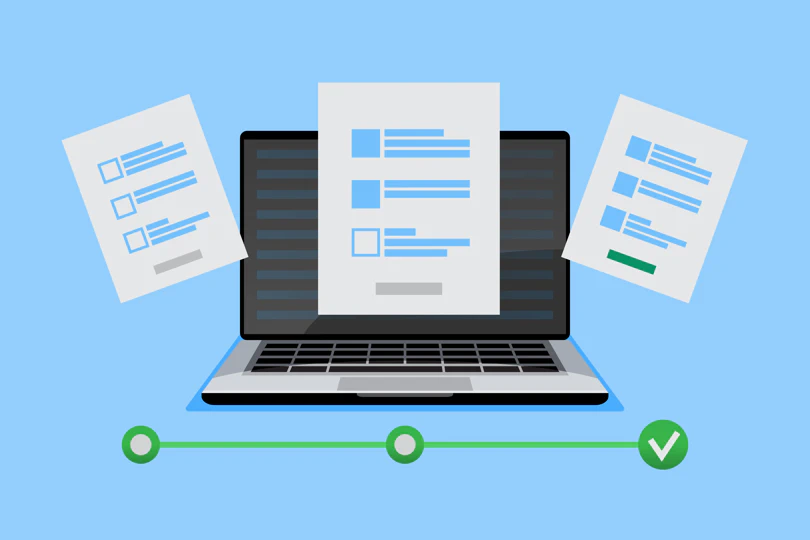Every step matters
Survey research should accurately measure the experiences and opinions of the people being surveyed. With that in mind, here are some important details to consider while designing, deploying, and reporting on your survey.

Pre-survey communications
Frequent, open communication about the survey process is key to success. Keeping everyone in the loop will bring people together, ensuring common problems and solutions are brought to the forefront and action plans are made that make the company more successful.
We suggest beginning with an announcement to build support and enthusiasm — company-wide for employee and customer surveys and possibly just your marketing organization for market research.
Include basic information in the announcement about the purpose of the research, the deployment dates, and when results are expected to be available.

Survey layout
Proper placement of your company name, logo, survey name, opening paragraph, and the question order are all important details to consider. Your survey layout should encourage maximum participation while gathering unbiased responses.
The heading of the first page of your survey should contain your logo, your company name, and the survey name. Beneath the heading should be an opening paragraph from a senior executive, the company president, or the CEO that explains the process and why the survey is being conducted.
After the opening paragraph, include any demographic questions you want to ask.
After demographics, provide instructions on how to respond to the survey, particularly with regard to any scaled questions. Then, the questions begin.

Survey scale
Survey scales gather data to gauge respondents’ attitudes, opinions, and beliefs. The most popular survey scale asks respondents to rate their level of agreement with a survey question.
Scaled questions give you ample flexibility for data analysis, but they must be kept balanced to avoid response bias. A six-point scale with three levels of disagreement and three levels of agreement tends to work best.
If possible, stay away from neutral ratings, such as “I don’t know” or “Neither Agree nor Disagree”. Neutral options can negatively impact your data collection.
Learn More
Survey length
Think about how long respondents are willing to spend answering your survey. The length of the survey will effect how long it takes to respond, the quality of the responses, and the response rate.
NBRI surveys are typically 20 questions (for customer surveys) to 60 questions (for employee surveys), including a company logo, an opening paragraph, demographics, and instructions. The length of market research surveys is situation dependent. The ideal length depends upon your audience and the survey type. But while you’re collecting information, it is important to get all of the information you need to make informed business decisions.
Survey questions must be clearly written statements that get right to the point, producing actionable data. They should take only seconds to rate, so 60 questions may be used in a survey and respondents will still be able to complete it in 10 minutes!

Open-ended questions
Including open-ended questions on your survey can be beneficial for several reasons. First, the responses provide context — in the respondents’ own words — for the answers you receive to close-ended questions. Second, the answers can be used to improve future surveys by identifying topics or questions that were left off of the current survey.
When NBRI collects your survey data, we provide Survey Comment Reports where comments from open-ended questions are presented verbatim.
Text Analytics Reports — generated using artificial neural networking and managed machine learning to extract the most meaningful information from the responses — are also available.

Communications after the survey
Thank participants for their time and candor. If your response rate was high, acknowledge that. If you reached any specific response rate goals, recognize those achievements.
Regardless of whether your survey results are generally good or bad, keep the tone of your message positive — or at least neutral. Don’t focus on failures to reach targets or disappointments with the response rate or the results.
If the results are mostly negative, you may want to acknowledge that “there is a lot of work to be done,” but emphasize that you are eager to tackle the issues and excited about the positive changes that will be coming soon.

Sharing results
Be fair and honest in what you share. Don’t share only the positives while omitting obvious problems. Employees know what the problems are. Acknowledging problems openly will help you gain credibility and respect. Don’t focus only on the problems, either. Seek some degree of balance.
If your results are overwhelmingly negative and you can’t find very much positive to talk about, you probably need to simply acknowledge the seriousness of the problems. This is your chance to turn the corner and set things moving in the right direction.

Communicating the action plan
Make sure the senior leadership is on the same page and supportive of the action plan. Show employees that you are a united front, and convey your strength and competence as a leadership team.
Also, ensure that managers are not blindsided. Share the survey results and your action plan with all managers before communicating to employees. This allows managers to be prepared for any questions that might arise. It can also help generate support and buy-in from managers.
The action plan should include some steps that can be done quickly and that are easy for employees to observe. It should also include some longer-term, more substantive plans that will have a deeper impact but that will take longer to implement and achieve.

Ongoing communications
Establish a pattern of regular communication about senior leadership’s commitment to the action plan. Share progress toward goals, milestones reached, and other related activities.
Ongoing communications can also help drive accountability. When employees are reminded of promises that were made and goals that were set, the people responsible for delivering on those promises are more likely to follow through.

When and how often to repeat the survey
Finally, it will be time to repeat the survey to measure progress and also to assess whether any new problems have emerged.
For many organizations, repeating an employee survey after one year makes the most sense. It usually takes about a year for a company to analyze employee survey results, implement an action plan, and for employees to observe the changes and shift their attitudes. Customer surveys may be more frequent depending upon how often valid data can be achieved and how quickly you can move change initiatives through the organization. The repetition of market research studies is driven by the real-time need for information to improve products/services, brand positioning, pricing, etc.
For companies that are undergoing significant changes (like a merger or a major restructuring), a follow-up survey can be conducted after three to six months.
More frequent employee, customer, and market research pulse surveys are recommended for organizations that can handle the logistics and that want to stay on top of emerging employee, customer, and market issues.

























 By submitting this form you agree to our
By submitting this form you agree to our